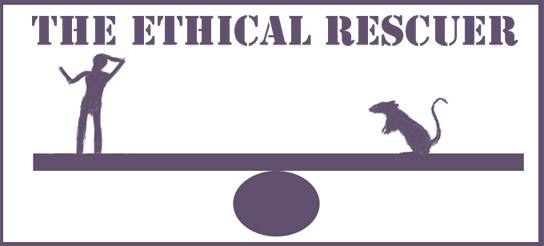EOTM will be returning in a day or so.
I'm sorry for my absence, especially int he beginning of my blog! I've had one hell of a week.
Last night though taught me one of the most important lessons I will ever learn in rescuing: even if they say they treat exotics in their ad make ABSOLUTE CERTAIN the doctors on staff at your local Emergency Vet will see your type of animal.
Last night there was an accident. I've been working on introing two groups of rats together and while there was some dominance battles there was nothing major. One of the new rats, a young neutered male named Damien, is a squealer. In rat terms, he's very rude. Rather than accepting the alpha female's dominance he screams and mutters protests. He screams if other rats touch him or even look at him funny. This screaming sets off the alpha-female Apocalypse. Up until last night all she would do is flip him over everytime he made a peep.
Last night I was putting them in after free-range time and I lifted Damien in a box with a small opening. Thinking nothing of it I plopped the box into the cage. Another girl came in and he started protesting, which set off the alpha female to run in there to make him stop. Being that there was only one exit and the other female blocked the way, he was trapped. He wouldn't stop screaming, so rather than flip him as she normally did, she outright attacked him drawing blood for the first time in 2 weeks they'd been together.
I pulled him out and saw he was bleeding badly. Closer inspection revealed several superficial wounds and one major bitewound in the pad of his back foot. It was very scary. We put pressure on the wound and after 5 minutes of seeing if it stopped called the e-vet for advice and possible stitches.
They refused to see him. They don't treat rats.
"Put pressure on it" they told me. I said I had and by this point it was 10 minutes and a lot of blood loss. "Well he may need stitches" said the woman on the other end.
"So I can bring him in?"
"No. You'll need to see *insert name of vet school here*
"But that's more than a two hours drive! he'll be dead before we get there!"
"Continue putting pressure on it. I'm sorry, we don't see exotics, unless you need euthanasia."
It's not that I don't understand that their doctor doesn't specialize in rats. I totally would not bring a rat/possum/cow to a cat or dog vet and expect them to know all of the ailments. But...stiches? I would think if they can perform (what I hope is) humane euthanasia they'd be capable of stitching a wound!
I got off the phone and he started to go into shock. We gave him a yogie (one of those unhealthy high sugar treats rats love so much and I am a sucker and give sparingly) and kept him warm; he came right back with the sugar. We used cornstarch as a stipic powder and cooled the limb. It finally stopped bleeding about 40 minutes later and he was weak and dehydrated (thankfully I keep carrots and pedialyte around). We are now in the cleaning the wounds and keeping them clean. He and his brother are back in a seperate cage.
My lesson is two-fold. One, never ever put a box in a cage of newly introduced rats that has only one small easily-blocked exit. Second, unless you call up infrequently and make sure they still see exotics and even if they do, never assume there is always an exotic vet on the nightshift. Also don't assume that E-vets are willing to see rodents, even if the problem is easy to treat.











